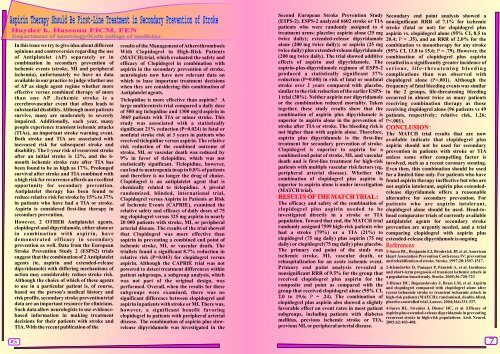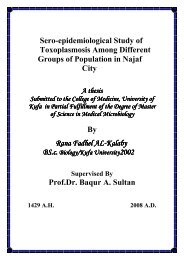Al-Najaf Medical BULLETIN - University of Kufa
Al-Najaf Medical BULLETIN - University of Kufa
Al-Najaf Medical BULLETIN - University of Kufa
You also want an ePaper? Increase the reach of your titles
YUMPU automatically turns print PDFs into web optimized ePapers that Google loves.
Aspirin Therapy Should Be First-Line Treatment in Secondary Prevention <strong>of</strong> Stroke<br />
Hayder k. Hassoun FICM, FEN<br />
Department <strong>of</strong> neurology/<strong>Kufa</strong> college <strong>of</strong> medicine<br />
In this issue we try to give idea about different<br />
opinions and controversies regarding the use<br />
<strong>of</strong> Antiplatelet (AP) separately or in<br />
combination in secondary prevention <strong>of</strong><br />
ischemic events (stroke, MI and peripheral<br />
ischemia), unfortunately we have no data<br />
available in our practice to judge whether use<br />
<strong>of</strong> AP as single agent regime whether more<br />
effective versus combined therapy <strong>of</strong> more<br />
than one AP .Ischemic stroke is a<br />
cecrebrovascular event that <strong>of</strong>ten leads to<br />
substantial disability. <strong>Al</strong>though most patients<br />
survive, many are moderately to severely<br />
impaired. Additionally, each year, many<br />
people experience transient ischemic attacks<br />
(TIAs), an important stroke warning event.<br />
Both stroke and TIA are associated with<br />
increased risk for subsequent stroke and<br />
disability. The1-year risk <strong>of</strong> recurrent stroke<br />
after an initial stroke is 12%, and the 6month<br />
ischemic stroke rate after TIA has<br />
been found to be as high as 17%. Prolonged<br />
survival after stroke and TIA combined with<br />
a high risk for recurrence affords an excellent<br />
opportunity for secondary prevention.<br />
Antiplatelet therapy has been found to<br />
reduce relative risk for stroke by 15% to 37%<br />
in patients who have had a TIA or stroke.<br />
Aspirin is considered first-line therapy in<br />
secondary prevention,<br />
However, 2 OTHER Antiplatelet agents,<br />
clopidogrel and dipyridamole, either aloneor<br />
in combination with aspirin, have<br />
demonstrated efficacy in secondary<br />
prevention as well. Data from the European<br />
Stroke Prevention Study 2 (ESPS2) trials<br />
suggest that the combination<strong>of</strong> 2 Antiplatelet<br />
agents (ie, aspirin and extended-release<br />
dipyridamole) with differing mechanisms <strong>of</strong><br />
action may considerably reduce stroke risk.<br />
<strong>Al</strong>though the choice <strong>of</strong> which <strong>of</strong> these agents<br />
to use in a particular patient is, <strong>of</strong> course,<br />
based on the person's medical history and<br />
risk pr<strong>of</strong>ile, secondary stroke preventiontrial<br />
data are an important resource for clinicians.<br />
Such data allow neurologists to use evidencebased<br />
information in making treatment<br />
decisions for their patients with stroke and<br />
TIA.With the recent publication <strong>of</strong> the<br />
results <strong>of</strong> the Management<strong>of</strong> Atherothrombosis<br />
With Clopidogrel in High-Risk Patients<br />
(MATCH) trial, which evaluated the safety and<br />
efficacy <strong>of</strong> Clopidogrel in combination with<br />
aspirin in the secondary prevention <strong>of</strong> stroke,<br />
neurologists now have new relevant data on<br />
which to base important treatment decisions<br />
when they are considering this combination <strong>of</strong><br />
Antiplatelet agents.<br />
Ticlopidine is more effective than aspirin? A<br />
large multicenteric trial compared a daily dose<br />
<strong>of</strong> 500 mg ticlopidine and 1300 mg/d aspirin in<br />
3069 patients with TIA or minor stroke. This<br />
study was associated with a statistically<br />
significant 21% reduction (P=0.024) in fatal or<br />
nonfatal stroke risk at 3 years in patients who<br />
received ticlopidine versus aspirin. The relative<br />
risk reduction <strong>of</strong> the combined outcome <strong>of</strong><br />
stroke, MI, or vascular death was reduced by<br />
9% in favor <strong>of</strong> ticlopidine, which was not<br />
statistically significant. Ticlopidine, however,<br />
can lead to neutropenia inup to 0.8% <strong>of</strong> patients<br />
and therefore is no longer the drug <strong>of</strong> choice.<br />
Clopidogrel is an antiplatelet agent that is<br />
chemically related to ticlopidine. A pivotal<br />
randomized, blinded, international trial,<br />
Clopidogrel versus Aspirin in Patients at Risk<br />
<strong>of</strong> Ischemic Events (CAPRIE), examined the<br />
relative safety and efficacy <strong>of</strong> daily doses <strong>of</strong> 75<br />
mg clopidogrel versus 325 mg aspirin in nearly<br />
20 000 patients with stroke, MI, or peripheral<br />
arterial disease. The results <strong>of</strong> the trial showed<br />
that Clopidogrel was more effective than<br />
aspirin in preventing a combined end point <strong>of</strong><br />
ischemic stroke, MI, or vascular death. The<br />
trialists found a significant 8.7% reduction in<br />
relative risk (P=0.043) for clopidogrel versus<br />
aspirin. <strong>Al</strong>though the CAPRIE trial was not<br />
powered to detect treatment differences within<br />
patient subgroups, a subgroup analysis, which<br />
was not part <strong>of</strong> the original design, was<br />
performed. Overall, when the results for these<br />
subgroups were examined, there was no<br />
significant difference between clopidogrel and<br />
aspirin inpatients with stroke or MI. There was,<br />
however, a significant benefit favoring<br />
clopidogrel in patients with peripheral arterial<br />
disease. The combination <strong>of</strong> aspirin plus slowrelease<br />
dipyridamole was investigated in the<br />
Second European Stroke Prevention Study<br />
(ESPS-2). ESPS-2 analyzed 6602 stroke or TIA<br />
patients who were randomly assigned to 4<br />
treatment arms: placebo; aspirin alone (25 mg<br />
twice daily); extended-release dipyridamole<br />
alone (200 mg twice daily); or aspirin (25 mg<br />
twice daily) plus extended-releasedipyridamole<br />
(200 mg twice daily). The trial showed additive<br />
effects <strong>of</strong> aspirin and dipyridamole. The<br />
aspirin-plus-dipyridamole regimen <strong>of</strong> ESPS-2<br />
produced a statistically significant 37%<br />
reduction (P=0.00l) in risk <strong>of</strong> fatal or nonfatal<br />
stroke over 2 years compared with placebo,<br />
similar to the risk reduction <strong>of</strong> the earlier ESPS-<br />
1 trial (38%). Neither aspirin nor dipyridamole<br />
or the combination reduced mortality. Taken<br />
together, these study results show that the<br />
combination <strong>of</strong> aspirin plus dipyridamole is<br />
superior to aspirin alone in the prevention <strong>of</strong><br />
stroke after TIA or stroke. The bleeding risk is<br />
not higher than with aspirin alone. Therefore,<br />
aspirin plus dipyridamole is the first-line<br />
treatment for secondary prevention <strong>of</strong> stroke.<br />
Clopidogrel is superior to aspirin for a<br />
combined end point <strong>of</strong> stroke, MI, and vascular<br />
death and is first-line treatment for high-risk<br />
patients with multiple vascular risk factors (eg,<br />
peripheral arterial disease). Whether the<br />
combination <strong>of</strong> clopidogrel plus aspirin is<br />
superior to aspirin alone is under investigation<br />
Secondary end point analysis showed a<br />
nonsignificant RRR <strong>of</strong> 7.1% for ischemic<br />
stroke (fatal or not) for clopidogrel plus<br />
aspirin vs. clopidogrel alone (95% CI, 8.5 to<br />
20.4; P = .35), and an RRR <strong>of</strong> 2.0% for the<br />
combination vs monotherapy for any stroke<br />
(95% CI, 13.8 to 15.6; P = .79). However, the<br />
combination <strong>of</strong> clopidogrel plus aspirin<br />
resulted in a significantly greater incidence <strong>of</strong><br />
s e r i o u s , l i f e - t h r e a t e n i n g b l e e d i n g<br />
complications than was observed with<br />
clopidogrel alone (P



